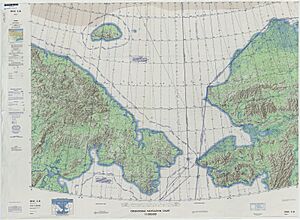Pre-Columbian trans-Bering Strait contact facts for kids
Imagine a time long, long ago, when people traveled across a land bridge that connected Asia and North America! For thousands of years, people have moved between what is now Siberia and Alaska across the Bering Strait. This journey helped shape the cultures and languages of many groups living in both places today.
Contents
Ancient Journeys Across the Bering Strait
The first people to arrive in the Americas, called Paleo-Indians, came during the last Ice Age. They walked across a land bridge that appeared when sea levels were much lower. Later, around 8,000 BCE, another group of people from Asia arrived in Alaska. These "Na-Dene" people settled in the far north of the Americas.
Even later, around 4,000 to 3,000 BCE, Eskimo people began moving from Siberia to the Americas. Today, Eskimo tribes live in both Asia and North America. This shows how connected these regions have been for a very long time.
Clues from Old Objects
Scientists and archaeologists often find old objects that tell us stories about the past. These discoveries help us understand how people lived and interacted.
Bronze and Obsidian Discoveries
In a 1,000-year-old house in Alaska, archaeologists found some amazing things. They discovered bronze artifacts! At that time, people in Alaska didn't know how to make bronze. This suggests the bronze came from nearby Asia, possibly from places like China, Korea, or Russia.
They also found obsidian artifacts in the same house. Obsidian is a type of volcanic glass. Scientists could tell from its chemical makeup that this obsidian came from the Anadyr River valley in Russia. These finds are strong clues that people traded goods across the Bering Strait long before Europeans arrived.
Weapons and Armor from Asia
Other items also show connections between Asia and North America. For example, a type of war bow used in Asia seems to have arrived in North America around the 700s AD. Also, a special kind of laminar armour (armor made of overlapping plates) appeared in North America around the 900s AD. These items likely traveled across the Bering Strait, showing how ideas and technologies spread.
Marco Polo's Mysterious Maps
You might know about Marco Polo, the famous explorer who traveled to the Far East. His family drew several maps based on his adventures. These maps were signed by his three daughters. What's really interesting is that some of these maps might even show the coastlines of Alaska!
Marco Polo's journey happened between 1271 and 1295. The maps themselves are thought to be copies made in the 1400s or 1500s. It's a mystery whether the Alaska coastline was on the original maps or added later.
Amazing Metal Finds in Alaska
In 2016, researchers from Purdue University and other universities shared exciting news. They studied six metal pieces found at a place called Cape Espenberg in Alaska. These items were from a time before Europeans had regular contact with North America.
Scientists used special X-ray tools to examine the metal. They found that two of the items were made of smelted metals like tin and lead. This was the first clear proof that metal from Asia reached prehistoric North America. It shows that people traded these metals across the Bering Strait to the Inuit people in Alaska. These items, a bead and a buckle, date back to around 1100-1300 AD. The buckle even looked like parts of horse harnesses used in ancient China!
Venetian Beads: A Long Journey
In 2021, another incredible discovery was announced. Tiny glass trade beads from Venice, Italy, were found at three ancient Eskimo sites in Alaska. One of these sites, Punyik Point, was on old trade routes from the Bering Sea to the Arctic Ocean.
Researchers believe these beads traveled a very long way. They likely went across Europe, then Eurasia, and finally over the Bering Strait to Alaska. This means they are the first proven European items found in prehistoric North America that arrived by land. Scientists used radiocarbon dating on nearby materials and estimated the beads arrived between 1440 and 1480. This would be before Christopher Columbus's famous voyage! However, some other researchers think the beads might have been made later, in the 1500s or 1600s.


